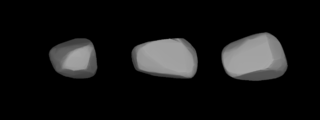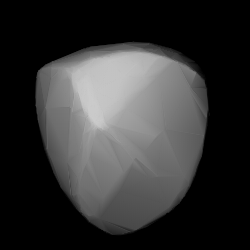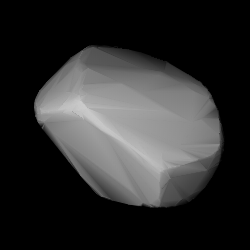
1996 Adams, provisional designation 1961 UA, is a stony Eunomia asteroid from the middle region of the asteroid belt, approximately 13 kilometers in diameter. It was discovered on 16 October 1961, by the Indiana Asteroid Program at Goethe Link Observatory near Brooklyn, Indiana, United States. It was later named after mathematician John Couch Adams.
2023 Asaph, provisional designation 1952 SA, is a dark asteroid from the outer regions of the asteroid belt, approximately 21 kilometers in diameter. It was discovered on 16 September 1952, by astronomers of the Indiana Asteroid Program at Goethe Link Observatory in Indiana, United States.
1203 Nanna, provisional designation 1931 TA, is a carbonaceous asteroid from the outer region of the asteroid belt, about 35 kilometers in diameter. It was discovered on 5 October 1931, by German astronomer Max Wolf at Heidelberg Observatory in southwest Germany, and named after Anna Risi, a model and mistress of painter Anselm Feuerbach.
1033 Simona, provisional designation 1924 SM, is a stony Eoan asteroid from the outer regions of the asteroid belt, approximately 20 kilometers in diameter. The asteroid was discovered by George Van Biesbroeck in 1924, who named it after his daughter Simona.

1129 Neujmina is an Eos asteroid from the outer regions of the asteroid belt. It was discovered on 8 August 1929, by astronomer Praskoviya Parchomenko at the Simeiz Observatory on the Crimean peninsula. The stony S-type asteroid has a rotation period of 5.1 hours and measures approximately 34 kilometers in diameter. It was named after Soviet astronomer Grigory Neujmin.

1132 Hollandia, provisional designation 1929 RB1, is a stony asteroid from the middle region of the asteroid belt, approximately 27 kilometers in diameter. It was discovered on 13 September 1929, by Dutch astronomer Hendrik van Gent at Leiden Southern Station, annex to the Johannesburg Observatory in South Africa. It was named for the region Holland in the Netherlands.
1164 Kobolda, provisional designation 1930 FB, is a stony Phocaea asteroid from the inner regions of the asteroid belt, approximately 7 kilometers in diameter. Discovered by Karl Reinmuth at Heidelberg Observatory in 1930, the asteroid was later named after German astronomer Hermann Kobold.
1194 Aletta, provisional designation 1931 JG, is a carbonaceous asteroid from the outer region of the asteroid belt, approximately 55 kilometers in diameter. It was discovered on 13 May 1931, by South African astronomer Cyril Jackson at Johannesburg Observatory in South Africa. It was later named after the discoverer's wife Aletta Jackson.
6296 Cleveland, provisional designation 1988 NC, is a Hungaria asteroid from the innermost regions of the asteroid belt, approximately 3.5 kilometers in diameter. It was discovered on 12 July 1988, by American astronomer Eleanor Helin at the Palomar Observatory in California. The presumed E-type asteroid has a long rotation period of 30.8 hours and possibly an elongated shape. It was named for the city of Cleveland in the U.S. state of Ohio.
3915 Fukushima, provisional designation 1988 PA1, is a carbonaceous asteroid from the inner regions of the asteroid belt, approximately 21 kilometers in diameter.
1177 Gonnessia, provisional designation 1930 WA, is a dark background asteroid from the outer regions of the asteroid belt, approximately 99 kilometers in diameter. It was discovered on 24 November 1930, by French astronomer Louis Boyer at the Algiers Observatory in Algeria, North Africa, and named after astronomer François Gonnessiat.
5333 Kanaya, provisional designation 1990 UH, is a carbonaceous asteroid from the inner regions of the asteroid belt, approximately 14 kilometers in diameter.
1384 Kniertje, provisional designation 1934 RX, is a dark Adeonian asteroid from the central regions of the asteroid belt, approximately 26 kilometers in diameter. It was discovered on 9 September 1934, by Dutch astronomer Hendrik van Gent at the Union Observatory in Johannesburg, South Africa. The asteroid was named after a character in the Dutch play Op Hoop van Zegen by Herman Heijermans.
1318 Nerina, provisional designation 1934 FG, is a Phocaea asteroid from the inner regions of the asteroid belt, approximately 13 kilometers in diameter. It was discovered on 24 March 1934, by South African astronomer Cyril Jackson at the Union Observatory in Johannesburg. The possibly metallic X-type asteroid has a notably short rotation period of 2.5 hours. It was named for the flowering plant Nerine, also known as "Guernsey lily" or "Jersey lily".
2036 Sheragul, provisional designation 1973 SY2, is a rare-type Florian asteroid from the inner regions of the asteroid belt, approximately 7 kilometers in diameter. The asteroid was discovered on 22 September 1973, by Soviet astronomer Nikolai Chernykh at the Crimean Astrophysical Observatory in Nauchnij, on the Crimean peninsula. It was named after the Russian village of Sheragul in eastern Siberia.
1258 Sicilia, provisional designation 1932 PG, is a dark background asteroid from the outer regions of the asteroid belt, approximately 44 kilometers in diameter. It was discovered on 8 August 1932, by astronomer Karl Reinmuth at the Heidelberg-Königstuhl State Observatory in southwest Germany. The asteroid was named after the Italian island of Sicily.

2120 Tyumenia is a dark background asteroid, approximately 45 kilometers in diameter, located in the outer regions of the asteroid belt. It was discovered on 9 September 1967, by Soviet astronomer Tamara Smirnova at the Crimean Astrophysical Observatory in Nauchnyj, on the Crimean peninsula. The asteroid was named for the now Russian district of Tyumen Oblast in Western Siberia.
1708 Pólit, provisional designation 1929 XA, is a very dark asteroid from the outer region of the asteroid belt, approximately 29 kilometers in diameter. It was discovered on 30 November 1929, by Spanish astronomer of Catalan origin Josep Comas i Solà at the Fabra Observatory in Barcelona, and was later named after Catalan astronomer Isidre Pòlit i Boixareu.

1600 Vyssotsky, provisional designation 1947 UC, is a rare-type Hungaria asteroid and suspected interloper from the inner regions of the asteroid belt, approximately 7 kilometers in diameter. It was discovered on 22 October 1947, by American astronomer Carl Wirtanen at Lick Observatory in California, United States. It was named after astronomer Alexander Vyssotsky.
52266 Van Flandern, provisional designation 1986 AD, is a stony Phocaea asteroid from the inner regions of the asteroid belt, approximately 4 kilometers in diameter. It was discovered on 10 January 1986, by American astronomers Carolyn and Eugene Shoemaker at the Palomar Observatory in California, United States. The asteroid was later named for American astronomer Tom Van Flandern.





